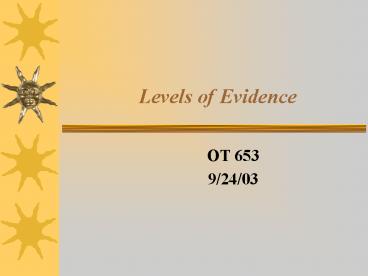Levels of Evidence PowerPoint PPT Presentation
1 / 26
Title: Levels of Evidence
1
Levels of Evidence
- OT 653
- 9/24/03
2
What is evidence?Support for clinical practice,
theory, assessments, and clinical research
evolved from systematic study
3
(No Transcript)
4
Randomized Controlled Trials
- Control group
- Manipulate a variable
- Random assignment
- Double-blinded (persons administering the
treatment and evaluating the outcomes are both
blinded to who receives what intervention)
5
Other Kinds of Experimental Designs
- Studies where groups are small (under 30)
- Lack of blinding of researcher or data
collector or data analyzer
6
Cohort Studies
- Follows one or more groups (cohorts)
- Follows the group over a defined time
- prospectively
- Often used to follow a group of individuals
over a period of time to see if a certain
condition develops. - Helps to delineate risk factors for conditions
- Not randomized
7
Case-Control Studies
- Similar to cohort studies BUT
- Are retrospective
- Subjects in two groups are matched -
participants with a condition in one group and
participants without in the second group or
cohort - Identify risk factors, make predictions
- Do not identify causation
8
Quasi-experimental Studies
- Studies without a control group
- Studies without a control group and without
random assignment - Studies where either pre and post intervention
measures are collected, or sometimes just post
intervention measures
9
Cross-sectional studies
- Data collected on a group at one point in time
- The group studied may be stratified
- Conclusions are drawn about the trait studied
10
So how are all these kinds of research worked
into an evidence-based review??
11
Evaluating the Evidence
- Doing a literature review
- Analyzing kinds of evidence you
- find
- Deciding which articles to include in
- your review
- Ranking kinds of research
12
Ranking articles for an evidence-based review is
carried out using levels of evidence hierarchies.
13
Such hierarchies are a way to rank kinds of
research studies in a systematic and consistent
manner.
14
Levels of Evidence
- There are a number of levels or typologies of
evidence - Groups like the Cochrane Collection or the
PEDRO group out of Australia use very rigorous
levels
15
http//www.pedro.fhs.usyd.edu.au/Links/links.htm
16
In the Future
- For clinicians, use of high levels of evidence
often results in finding very limited studies - Fields like physical and occupational
- therapy (even medicine) will have more
- RCTs available in the future as evidence
- Use of more rigorous levels of evidence
- will be mandatory
- In the meantime, practicing clinicians
- need to use levels commiserate with
- existing evidence
17
Laws Levels of Evidence
- Level I - RCTs or meta-analysis of RCTs
- Level II - Small RCTs
- Level III - Nonrandomized, controlled or cohort
studies case series case-controlled or
cross-sectional studies - Level IV - opinions of respected authorities or
expert committees consensus statements - Level V - Opinions of individuals who have
written guidelines based on experience,
literature reviews, and discussion with peers.
18
Systematic Reviews/Meta-Analyses
- Systematic Reviews - comprehensive reviews of the
literature that provide an overview of validity
of research methods and results for a particular
topic - Meta-Analyses - a systematic review in which
studies are summarized statistically
19
Problem - Laws levels of evidence is very
rigorous and may exclude much of the research
that exists in occupational therapy
20
Holms Levels of Evidence
- Level I - Systematic reviews, meta-analytic
studies - Level II - Randomized controlled trials
- Level III - Trials without randomization
- Level IV - Nonexperimental studies from more than
one center - Level V - Opinions of respected authorities based
on clinical evidence, descriptive studies or
reports of expert committees - (Holm, 2000, p.581)
21
Level III
- Studies included in Level III are studies
without randomization, cohort studies, or
case-control studies. (FOR THE PURPOSE OF THIS
CLASS, PUT SINGLE SUBJECT DESIGNS IN LEVEL III).
22
Level IV
- To be classified as Level IV, studies must
include data from more than one site, i.e.
multiple classrooms, several clinical or practice
sites, more than one university setting.
23
Level V criteria
- Qualitative studies
- Descriptive studies from individual centers
- White papers, The Issue is, published
standards of care
24
For your group reviews...
- A table citing articles included in your paper
grouped by levels of evidence - You do NOT have to do a critique using the form
from last semester on meta-analyses or systematic
reviews done by groups such as the Cochrane
Collection - You MUST have a critique on all other articles
except expert opinion papers
25
http//www.uab.edu/shrpot/Laura20Vogtle/OT667/Sch
ool20Based.pdf
26
http//www.uab.edu/shrpot/Laura20Vogtle/OT667/Cas
e20Study20Article20Critique.pdf

